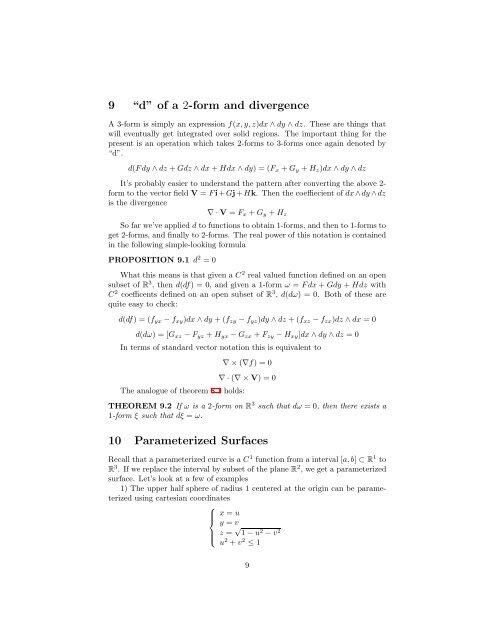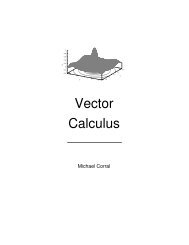Introduction to differential forms
Introduction to differential forms
Introduction to differential forms
Create successful ePaper yourself
Turn your PDF publications into a flip-book with our unique Google optimized e-Paper software.
9 “d” of a 2-form and divergence<br />
A 3-form is simply an expression f(x, y, z)dx ∧ dy ∧ dz. These are things that<br />
will eventually get integrated over solid regions. The important thing for the<br />
present is an operation which takes 2-<strong>forms</strong> <strong>to</strong> 3-<strong>forms</strong> once again denoted by<br />
“d”.<br />
d(F dy ∧ dz + Gdz ∧ dx + Hdx ∧ dy) = (F x + G y + H z )dx ∧ dy ∧ dz<br />
It’s probably easier <strong>to</strong> understand the pattern after converting the above 2-<br />
form <strong>to</strong> the vec<strong>to</strong>r field V = F i + Gj + Hk. Then the coeffiecient of dx ∧ dy ∧ dz<br />
is the divergence<br />
∇ · V = F x + G y + H z<br />
So far we’ve applied d <strong>to</strong> functions <strong>to</strong> obtain 1-<strong>forms</strong>, and then <strong>to</strong> 1-<strong>forms</strong> <strong>to</strong><br />
get 2-<strong>forms</strong>, and finally <strong>to</strong> 2-<strong>forms</strong>. The real power of this notation is contained<br />
in the following simple-looking formula<br />
PROPOSITION 9.1 d 2 = 0<br />
What this means is that given a C 2 real valued function defined on an open<br />
subset of R 3 , then d(df) = 0, and given a 1-form ω = F dx + Gdy + Hdz with<br />
C 2 coefficents defined on an open subset of R 3 , d(dω) = 0. Both of these are<br />
quite easy <strong>to</strong> check:<br />
d(df) = (f yx − f xy )dx ∧ dy + (f zy − f yz )dy ∧ dz + (f xz − f zx )dz ∧ dx = 0<br />
d(dω) = [G xz − F yz + H yx − G zx + F zy − H xy ]dx ∧ dy ∧ dz = 0<br />
In terms of standard vec<strong>to</strong>r notation this is equivalent <strong>to</strong><br />
The analogue of theorem 8.1 holds:<br />
∇ × (∇f) = 0<br />
∇ · (∇ × V) = 0<br />
THEOREM 9.2 If ω is a 2-form on R 3 such that dω = 0, then there exists a<br />
1-form ξ such that dξ = ω.<br />
10 Parameterized Surfaces<br />
Recall that a parameterized curve is a C 1 function from a interval [a, b] ⊂ R 1 <strong>to</strong><br />
R 3 . If we replace the interval by subset of the plane R 2 , we get a parameterized<br />
surface. Let’s look at a few of examples<br />
1) The upper half sphere of radius 1 centered at the origin can be parameterized<br />
using cartesian coordinates<br />
⎧<br />
⎪⎨<br />
⎪⎩<br />
x = u<br />
y = v<br />
z = √ 1 − u 2 − v 2<br />
u 2 + v 2 ≤ 1<br />
9








